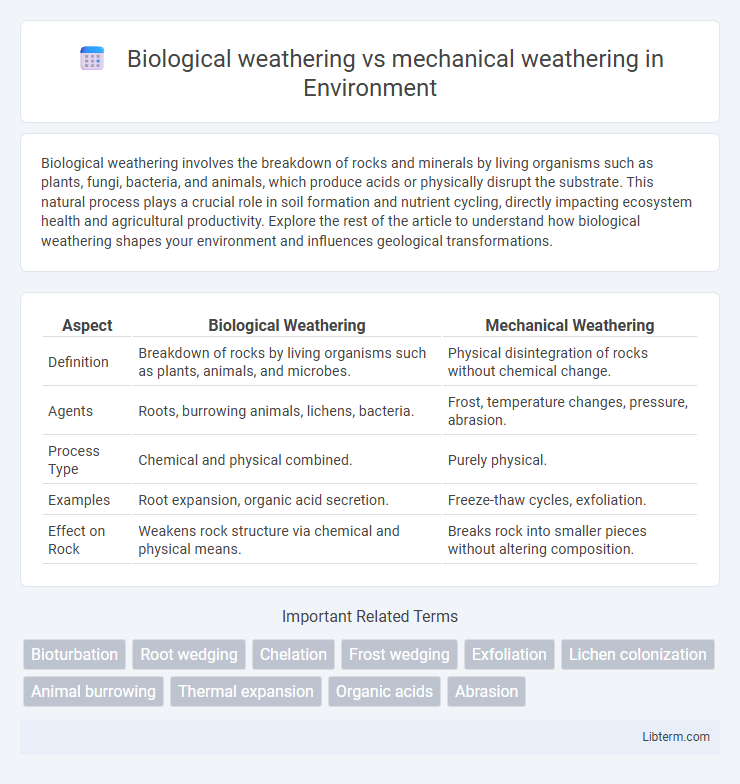Biological weathering involves the breakdown of rocks and minerals by living organisms such as plants, fungi, bacteria, and animals, which produce acids or physically disrupt the substrate. This natural process plays a crucial role in soil formation and nutrient cycling, directly impacting ecosystem health and agricultural productivity. Explore the rest of the article to understand how biological weathering shapes your environment and influences geological transformations.
Table of Comparison
| Aspect | Biological Weathering | Mechanical Weathering |
|---|---|---|
| Definition | Breakdown of rocks by living organisms such as plants, animals, and microbes. | Physical disintegration of rocks without chemical change. |
| Agents | Roots, burrowing animals, lichens, bacteria. | Frost, temperature changes, pressure, abrasion. |
| Process Type | Chemical and physical combined. | Purely physical. |
| Examples | Root expansion, organic acid secretion. | Freeze-thaw cycles, exfoliation. |
| Effect on Rock | Weakens rock structure via chemical and physical means. | Breaks rock into smaller pieces without altering composition. |
Introduction to Weathering Processes
Biological weathering involves the breakdown of rocks through the actions of living organisms such as plants, fungi, and bacteria, which produce acids or physically disrupt rock structures. Mechanical weathering, also known as physical weathering, refers to the fragmentation of rocks into smaller pieces without altering their chemical composition, driven by processes like freeze-thaw cycles, abrasion, and thermal expansion. Both processes contribute to soil formation and landscape evolution by gradually disintegrating rock materials.
Defining Biological Weathering
Biological weathering refers to the breakdown of rocks and minerals caused by the actions of living organisms such as plants, fungi, bacteria, and animals. This process includes root growth that fractures rock, microbial activity that produces organic acids, and burrowing animals accelerating mechanical disintegration. Unlike mechanical weathering, which relies solely on physical forces like temperature changes and abrasion, biological weathering involves biochemical interactions that alter mineral composition and promote rock decay.
Defining Mechanical Weathering
Mechanical weathering refers to the physical breakdown of rocks into smaller fragments without altering their chemical composition. Processes like freeze-thaw cycles, abrasion, and thermal expansion cause rocks to crack and disintegrate through repeated stress. This contrasts with biological weathering, where living organisms, such as plant roots and microbes, contribute to rock fragmentation by both physical force and chemical secretion.
Key Differences Between Biological and Mechanical Weathering
Biological weathering involves the breakdown of rocks through the actions of living organisms, such as plant roots growing into cracks or acids produced by microbes, whereas mechanical weathering physically fractures rocks without chemical change, often through processes like freeze-thaw cycles or abrasion. Biological weathering causes both physical disruption and chemical alteration, while mechanical weathering is purely physical, leading to smaller rock fragments. The rate of biological weathering depends on the presence of organisms and environmental conditions, contrasting with mechanical weathering, which is influenced primarily by temperature fluctuations and physical forces.
Agents of Biological Weathering
Biological weathering involves living organisms such as plant roots, microbes, and fungi breaking down rocks chemically and physically, while mechanical weathering is the physical disintegration of rocks without chemical change. Agents of biological weathering include tree roots that penetrate rock fractures, lichens that secrete acidic substances to dissolve minerals, and burrowing animals that expose fresh rock surfaces to other weathering processes. These biological agents accelerate rock decomposition by combining physical disruption with biochemical reactions, enhancing soil formation and mineral cycling in ecosystems.
Agents of Mechanical Weathering
Mechanical weathering is driven by physical forces such as freeze-thaw cycles, thermal expansion, abrasion, and pressure release that break down rocks without altering their chemical composition. Key agents include ice wedging, where water freezes and expands in cracks, root wedging from plant roots growing into rock fractures, and exfoliation caused by the release of overlying pressure. These processes increase surface area, facilitating further weathering and erosion.
Examples of Biological Weathering in Nature
Biological weathering occurs when living organisms such as lichens, roots, and burrowing animals break down rocks through chemical and physical processes, unlike mechanical weathering which involves purely physical forces like freeze-thaw cycles or abrasion. Examples of biological weathering include tree roots growing into rock fractures, fungi releasing acidic compounds to decompose minerals, and earthworms aerating soil to promote mineral breakdown. This type of weathering plays a crucial role in soil formation and nutrient cycling in natural ecosystems.
Examples of Mechanical Weathering in Nature
Mechanical weathering in nature includes processes such as frost wedging, where water freezes and expands in rock cracks, causing the rock to break apart; thermal expansion from temperature fluctuations that cause rock layers to peel or fracture; and root wedging, where plant roots grow into rock crevices, exerting pressure that fractures the rock. These physical forces contribute to the disintegration of rocks without changing their chemical composition, contrasting with biological weathering, which involves organic acids and organisms altering the rock's chemistry. Examples like frost shattering in alpine environments and exfoliation in desert climates highlight the widespread impact of mechanical weathering.
Environmental Impacts of Both Weathering Types
Biological weathering accelerates rock decomposition through organic activities such as root growth and microbial secretion, significantly altering soil composition and nutrient cycling. Mechanical weathering physically breaks down rocks into smaller fragments without altering their chemical structure, increasing sediment transport and influencing landscape erosion rates. Both weathering types play critical roles in shaping terrestrial ecosystems by affecting soil fertility, sediment distribution, and habitat formation.
Conclusion: Importance of Understanding Weathering
Understanding the distinct processes of biological weathering, driven by living organisms such as plant roots and microbes, and mechanical weathering, caused by physical forces like freeze-thaw cycles, is crucial for accurate geological assessments. This knowledge informs soil conservation strategies, landscape management, and the prediction of erosion patterns, directly impacting agriculture and infrastructure stability. Effective weathering analysis supports environmental sustainability and helps mitigate natural hazards associated with rock degradation.
Biological weathering Infographic

 libterm.com
libterm.com